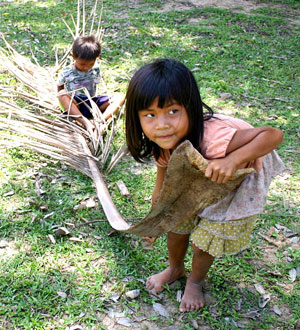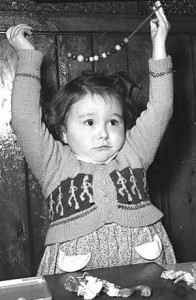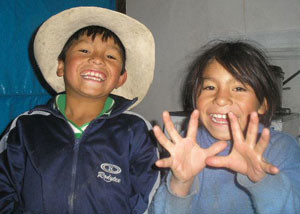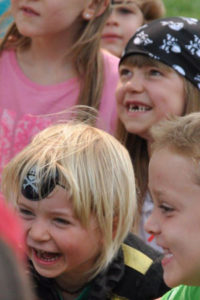
DIVING IN THE MOON
HONORING STORY, FACILITATING HEALING
Storytelling, Movement and Drama with Children
© Sue Proctor
Over many years of telling stories, I have discovered the healing value of imaginative play by using oral storytelling as a platform for exploring movement and drama with children. In storytelling for children, the teller has an opportunity to affirm the child’s inner voice. The process of artistic expression, for a person, young or old, brings focus to an internal reality which manifests through the art form. Working with children to embody or put a story into action, helps the child to clarify their understanding of the story and empowers the child to interpret and express their world. I have found that children spontaneously articulate stories as expressive play. In directing this process, the leader’s job is to help inform, focus, structure, and orchestrate this play.
The primary role of the storyteller as leader is to listen to the child’s response to the story and find a vehicle or container for the children to communicate and learn through expressing the story themselves. Children have a unique perception of the world around them that they are often eager to share with others. The story can become a catalyst for the child to understand and express their world. Young children are natural actors and have an innate ability to communicate with action and imagination.
 In this work, I have discovered that children, as young as two, can spontaneously start doing mime or symbolic expression. A two year old will pretend to be a monster or give you a pretend “cookie” or drive an imaginary car. They are delighted with adults who will participate in their imaginary world. Often everything seems possible to a child. Reality is limitless. Through the story play healing can occur because it calls on the whole child, the health of the child to come into practice as the reality shifts. A chair can be a space-ship, a skipping rope can be a snake, a hat can be a bowl. The world is open for discovery and expression. Most children are fascinated by stories. They will carefully follow the logical sequence of events with their innate curiosity. They will gladly create a lively sequence with ingenuity that sometimes surprises adult linear thinking. Children will continuously animate characters and emotions if given the opportunity – from a Magic T-Rex to a dying pony. Children often have a strong sense of empathy and compassion for others.
In this work, I have discovered that children, as young as two, can spontaneously start doing mime or symbolic expression. A two year old will pretend to be a monster or give you a pretend “cookie” or drive an imaginary car. They are delighted with adults who will participate in their imaginary world. Often everything seems possible to a child. Reality is limitless. Through the story play healing can occur because it calls on the whole child, the health of the child to come into practice as the reality shifts. A chair can be a space-ship, a skipping rope can be a snake, a hat can be a bowl. The world is open for discovery and expression. Most children are fascinated by stories. They will carefully follow the logical sequence of events with their innate curiosity. They will gladly create a lively sequence with ingenuity that sometimes surprises adult linear thinking. Children will continuously animate characters and emotions if given the opportunity – from a Magic T-Rex to a dying pony. Children often have a strong sense of empathy and compassion for others.
One five year old that I worked with chose to reenact an accident story from week to week. Some days he was the child who was being taken care of and bandaged, some days he was the doctor who was giving the care. It seemed that while he was playing through the story that inner wounds were being addressed and receiving healing.
Working with Story
 Acting out a story can be a significant way to express, yet contain, creative healing energy. The story can provide structure, characters, relationships, and a basic action line to inspire movement and imagination. The group or an individual could make up a story, or the leader could tell a story. Even with a book, the leader could tell a story using the pictures to follow the action line and illustrate important points. Children can participate by repeating phrases of conversation, answering questions and copying movements or gestures. When the story is acted out, one character can be played by a group of children pretending to be brothers or sisters. In this way the children can act in chorus and a large number of participants can act out the story. A simple movement game where children act out all the characters together can help them practice. The basic set up of space can be done with chairs as thrones, cars, tractors, fences, etc. Once the children have their parts and the space is set up, the leader retells the story and directs the action through narration. Often the story will need to be acted out twice so that everyone can get involved both as audience and performer.
Acting out a story can be a significant way to express, yet contain, creative healing energy. The story can provide structure, characters, relationships, and a basic action line to inspire movement and imagination. The group or an individual could make up a story, or the leader could tell a story. Even with a book, the leader could tell a story using the pictures to follow the action line and illustrate important points. Children can participate by repeating phrases of conversation, answering questions and copying movements or gestures. When the story is acted out, one character can be played by a group of children pretending to be brothers or sisters. In this way the children can act in chorus and a large number of participants can act out the story. A simple movement game where children act out all the characters together can help them practice. The basic set up of space can be done with chairs as thrones, cars, tractors, fences, etc. Once the children have their parts and the space is set up, the leader retells the story and directs the action through narration. Often the story will need to be acted out twice so that everyone can get involved both as audience and performer.
Factors To Consider
Humour
Children have a natural sense of humor. They are often delighted to be ‘silly’. Although containment and appropriate behavior are important it is also important that the children are able to enjoy and express themselves. Room for occasional silliness and well-intentioned, compassionate laughter can support healing. Laughter can help the shy children relax and give the over-active children a chance for expression and recognition.
Containment
It is important that children can be free to express themselves without being destructive to the rest of the group. This can be accomplished in different ways:
 Bubble of Space – Each child needs to have his or her own space around them with no touching allowed. Often children have difficulty with boundaries and the bubble gives them a clear image of limits. The leader needs to watch carefully and as soon as there is any physical contact that is disruptive, remind the child. The atmosphere must remain positive and fun.
Bubble of Space – Each child needs to have his or her own space around them with no touching allowed. Often children have difficulty with boundaries and the bubble gives them a clear image of limits. The leader needs to watch carefully and as soon as there is any physical contact that is disruptive, remind the child. The atmosphere must remain positive and fun.- 3-2-1 Freeze! The children move around the room embodying characters and then freeze like statues on command. As a still point is reached the leader can continue with directions or change the game.
Choice
The child must be able to not participate if they don’t want to. If the child is part of making up a story in a circle then they need the option to pass with no pressure. If the child doesn’t want to participate in an action game then they can sit by the wall and be audience. Every situation is different. Sometimes a child will be nervous to do something alone, but will be fine with a partner. Sometimes a child will be frightened by action. Sometimes they will have great verbal skills, but poor physical skills or visa versa. Sometimes the group can shift for the child, Sometimes the child will shift for the group. Sometimes the child will have serious problems that will make functioning in a dramatic group too difficult, but they still might be able to listen to the story and express themselves by making a sign or painting a picture.
Healing Benefits of Working with Story, Movement and Drama
- Comprehension and Communication – Children need to use thinking processes to understand the stories being told to them. Many stories, like folk tales and fairytales in particular, articulate life lessons and difficult situations that a child can identify with and work through. Talking about aspects of the story helps the child to gain a context for understanding experience and information that they have received through media and the world around them. In drama children have the opportunity to explore communication by using their voices and bodies in many different ways in order to articulate thoughts and emotions. Speaking for the characters, making animal noises or sound effects are all important aspects of the process. Most children can find a way of adding to the story. This helps them to develop their skills and gain confidence at a basic level. Often a child who cannot speak words can still growl like a bear.
- Physical Movement – Stories and songs stimulate physical movement as an enjoyable part of the creative process. Improvement in physical strength, flexibility and dexterity results naturally. Children who are not strong verbally can contribute physically.
 Emotional Release – Children can make loud noises, laugh and explore emotions in the context of the stories. As children laugh tense muscles relax and their color changes as their circulation is stimulated. Children can heal through expressing, understanding and finding acceptance for overwhelming emotions.
Emotional Release – Children can make loud noises, laugh and explore emotions in the context of the stories. As children laugh tense muscles relax and their color changes as their circulation is stimulated. Children can heal through expressing, understanding and finding acceptance for overwhelming emotions.- Empowerment – Within the context of the story development children are able to gain recognition, make choices and have a creative impact on their environment. The stories change according to which character they choose to play, what costume they choose to wear and what they are able to contribute to the story.
- Community Building – When children create an animated story or ‘play’ together in a stimulating but relaxed environment, they learn to work together, build relationships and appreciate each other’s differences.
- Presentation – Whether for their peers or their parents, presentation is a great way for children to express their talents and get positive feed back.
Conclusion
Working with children to develop stories can be a health giving, enjoyable, insightful and dynamic experience. Children are natural pretenders. Children usually love lots of action, costumes and music. I have found young children to be amazingly capable. I sometimes think that the task of an adult is to remember when playing stories was natural and bring that play into our storytelling today.

 Sue Proctor tells stories, writes stories and plays, performs as a clown and teaches creative drama with Manitoba Theatre for Young people, Manitoba Artist in the Schools Program and Association for Community Living, Winnipeg. She is on the board of the Manitoba Storytelling Guild.
Sue Proctor tells stories, writes stories and plays, performs as a clown and teaches creative drama with Manitoba Theatre for Young people, Manitoba Artist in the Schools Program and Association for Community Living, Winnipeg. She is on the board of the Manitoba Storytelling Guild.
